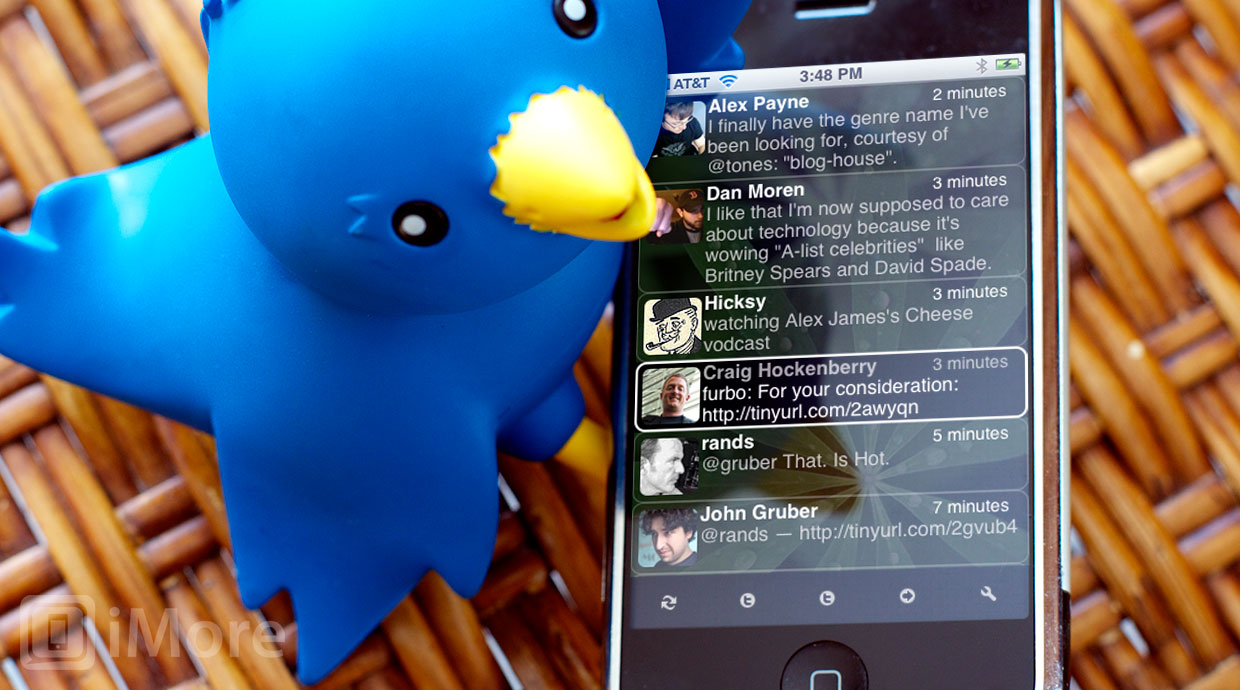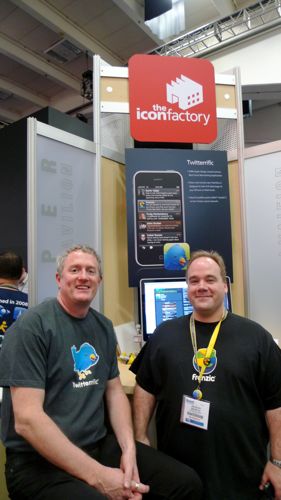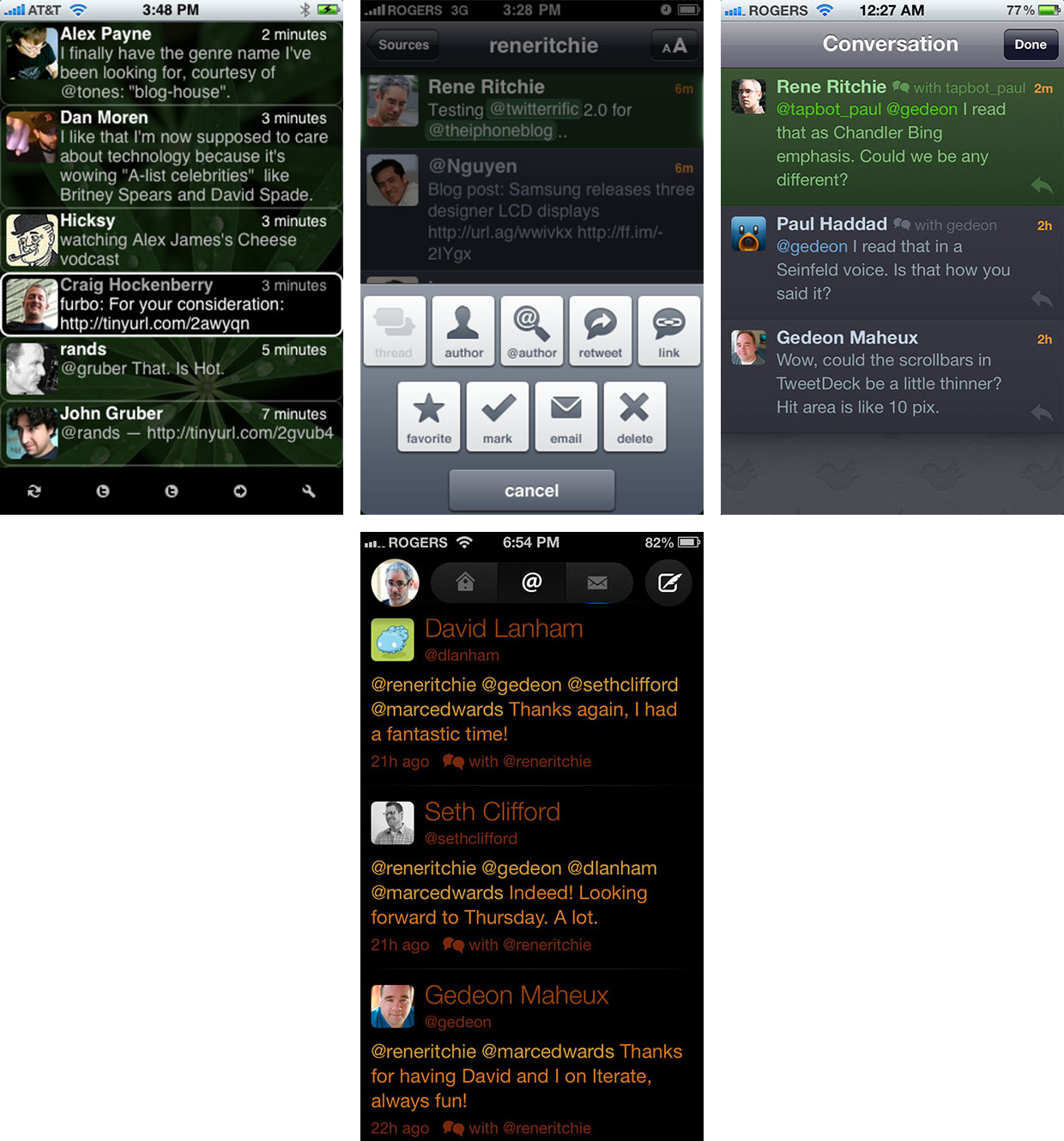Hall of fame: Craig Hockenberry, Gedeon Maheux, and Twitterrific

Twitterrific was the first native social networking client on the iPhone. Created by Craig Hockenberry and Gedeon Maheux of the Iconfactory, it began life as the Mobile Twitterrific in August of 2007, only two short months after the original iPhone shipped, and well before Apple announced even the plan for an official SDK. Development started "in the open", with a proof-of-concept made available on Google Project Hosting. Hockenberry wrote on Furbo at the time:
Don't expect much in terms of usability or elegance. The application only initiates a network connection to Twitter, downloads a timeline feed as XML, and then parses it into a data model. The user name from the model is then displayed in a table view. Sounds pretty simple, right?
It wasn't. The Twitter API was immature, the iPhone API not yet public, and the hundreds of small decisions and details, some of which may seem obvious in retrospect, all had to be discovered, considered, tested, and implemented. Twitter and the iPhone were two great things that could become even greater together, but it was up to Hockenberry and Maheux to realize it.
In September of 2007, Hockenberry posted the following tease on Furbo:
It's been rather quiet around here for the past couple of weeks. This is why:
It was accompanied by a screenshot of Twitterrific for iPhone, showing a timeline. Hockenberry later updated the post, saying that they'd be holding off on future development until the iPhone SDK event in 2008. When the App Store opened in June of 2008, Twitterrific was there first. And that's only one of an astounding list of firsts Twitterrific has racked up.
Twitterrific, in addition to being the first native Twitter client for iPhone, was the first native Twitter client for Mac, and one of the first on the iPad, arriving in the app store on launch day. Twitterrific was first to use a bird icon in association with a Twitter app, their signature Ollie. Twitterrific was first to describe a Twitter post as a Tweet. Twitterrific (still in beta at the time) was first to win an Apple Design Award for an iPhone social networking app. Twitterrific was first to provide a character counter, something of great value given the built-in limit of the service. Twitterrific was first to support @replies (now @mentions) and conversations. And the list goes on and on.
Yet the Iconfactory never rested on those laurels. They launched both a free (with ads) and a paid (premium) version of Twitterrific with the original App Store, to navigate around Apple's lack of trials. And they kept updating it.

Twitterrific 2 arrived in May of 2009, with Iconfactory designer David Lanham joining the team to handle the heavy interface lifting. By then other Twitter clients had appeared and feature escalation had begun. The Iconfactory managed to keep the surface layer of Twitterrific remarkably clean, but also managed to tuck away a lot of functionality thanks to deeper levels of interface. Louie Mantia, who was also at the Iconfactory at the time and contributed some elements, elaborated on it in a post on Mantia.
iMore offers spot-on advice and guidance from our team of experts, with decades of Apple device experience to lean on. Learn more with iMore!
Twitterrific 3, which launched alongside the iPad in 2010, saw the Iconfactory not only add a tablet-optimized interface, but step back and return to core functionality. Twitterrific had always been focused on the reading experience, and it returned to that focus with passion and discipline. Maheux wrote about the tough-love approach on gedblog:
Twitterrific 3 for iPhone benefits from all the work that has already gone into the iPad including: proper retweets, lists, saved searches and more. Add to this the long-awaited full landscape support that our users have been crying out for and Twitterrific is a whole new experience on the iPhone. All these things aside, rebooting the app in this fashion has allowed us to evaluate each feature on its own merits. Free of the pressure to include everything but the kitchen sink, Twitterrific now starts fresh and will gain new users. Once all the versions are in sync, we can concentrate on bringing updates to Twitterrific across all platforms simultaneously. This will hopefully allow us to avoid the pitfalls of having one version wildly out of sync with the rest (like the current Mac version).
Hockenberry and Lanham both shared their thoughts on the new release on as well, on Furbo and dlanham respectively.

Fast forward, and late 2012 saw Hockenberry, Maheux, and Lanham, as well as the Iconfactory's Sean Heber, release Twitterrific 5. Once again completely re-coded and re-designed, and once again returning to the core idea of Twitterrific, the team took everything that made the original Twitterrific great and boldly re-interpreted it for the current and next generation of Twitter users.
- $2.99 on sale - Download now
Hockenberry elaborated on the thinking behind the new version on Furbo:
As soon as you launch Twitterrific 5, you'll realize that it's a clean slate. The visual design is obviously a fresh start, but everything under the covers is as well. When presented with a clean slate, you're very careful what goes on it. It's best feature is simplicity.
Maheux and Lanham shared their thoughts with us as well, in an episode of Iterate, and Hockenberry and Heber did likewise for an upcoming episode of Debug (check back on Friday for that).
From a brand new and yet-to-be-released API in 2007, through intense competition, facing the often opaque constraints of the platform they built on, and increasing hostility from the service they targeted, the team at the Iconfactory have not only persevered, but triumphed, and in doing so they've helped inspire the developer community and delight the customer base alike.
That's why, as part of the inaugural iMore hall of fame, we're honoring Craig Hockenberry, Gedeon Maheux, and the granddaddy of all Twitter apps, Twitterrific.

Rene Ritchie is one of the most respected Apple analysts in the business, reaching a combined audience of over 40 million readers a month. His YouTube channel, Vector, has over 90 thousand subscribers and 14 million views and his podcasts, including Debug, have been downloaded over 20 million times. He also regularly co-hosts MacBreak Weekly for the TWiT network and co-hosted CES Live! and Talk Mobile. Based in Montreal, Rene is a former director of product marketing, web developer, and graphic designer. He's authored several books and appeared on numerous television and radio segments to discuss Apple and the technology industry. When not working, he likes to cook, grapple, and spend time with his friends and family.
